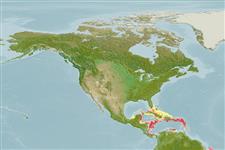>
Perciformes/Serranoidei (Groupers) >
Liopropomatidae (Painted basslets) > Liopropomatinae
Etymology: Liopropoma: Greek, leio = smooth + Greek, pro = in front of + Greek, poma, -atos = cover, operculum (Ref. 45335); olneyi: Named for John E. Olney..
Environment: milieu / climate zone / depth range / distribution range
Ekologi
laut; kisaran kedalaman 123 - 220 m (Ref. 95863). Tropical
Caribbean: adults are known from images and specimens from Curaçao. Larvae are known from the Florida Straits and Gulf of Mexico.
Size / Weight / umur
Maturity: Lm ? range ? - ? cm
Max length : 8.4 cm SL jantan/; (Ref. 95863)
deskripsi pendek
Kunci identifiaksi (pengenalan) | Morfologi | Morfometrik
Duri punggung (Keseluruhan (total)) : 9; duri punggung lunak (Keseluruhan (total)) : 11; Duri dubur: 3; Sirip dubur lunak: 8; vertebrata, bertulang belakang: 24. This liopropomin serranid is distinguished by the following set of adult and larval characters: D IX,11; A III, 8; pectoral fin 14-15; in adults - lateral-line scales 46-48, length of first dorsal spine 4.5% SL; margin of spinous dorsal fin shallowly indented posteriorly (fourth spine 9.7-12% SL, fifth spine only slightly shorter than fourth, 8.3-9.3% SL, and sixth-ninth spines approximately subequal, 5.5–8.9% SL); in larvae, second-eighth spines elongate, 57.1-150% SL; body of adults slender, depth at dorsal-fin origin 23% SL and the least caudal-peduncle depth is 13-15% SL. Predominant color of adults when alive is yellow; yellow covering dorsal portion of trunk, in stripe from tip of upper jaw to posterior edge of operculum and in narrower broken stripe from ventral edge of orbit to posterior edge of operculum, on dorsal and caudal fins, and in stripe on anal fin; top of head is dark rose/orange, ventral portions of head and trunk pale rose to white; dorsal and ventral portions of trunk with scattered yellow spots. When preserved in alcohol, the head and trunk uniformly pale, slightly paler on abdomen and throat. Larvae has a conspicuous pattern of orange chromatophores in life on head and trunk, orange pigment on elongate second dorsal-fin spine associated with swellings in sheath covering spine, several orange blotches on anal-fin rays, large blotch of orange pigment covering most of pelvic fin, and melanophores on spinous dorsal fin (Ref. 95863).
Collected from rocky slopes and ledges. When threatened, it retreats into small caves and crevices. Larva from Florida Straits was captured between 25 and 50 m (Ref. 95863).
Life cycle and mating behavior
Maturities | Reproduksi, perkembang biakan | Spawnings | Egg(s) | Fecundities | Larva
Baldwin, C. and G.D. Johnson, 2014. Connectivity across the Caribbean Sea: DNA barcoding and morphology unite an enigmatic fish larva from the Florida Straits with a new species of sea bass from deep reefs off Curaçao. PLoS ONE 9(5):e97661. (Ref. 95863)
Status IUCN Red List (Ref. 130435)
ancaman kepada manusia
Harmless
penggunaan manusia
Alat, peralatan
laporan khas
muat turun XML
Sumber internet
Estimates based on models
Preferred temperature (Ref.
123201): 19.7 - 23.7, mean 21.4 °C (based on 7 cells).
Phylogenetic diversity index (Ref.
82804): PD
50 = 0.5000 [Uniqueness, from 0.5 = low to 2.0 = high].
Bayesian length-weight: a=0.01122 (0.00514 - 0.02450), b=3.04 (2.87 - 3.21), in cm total length, based on all LWR estimates for this body shape (Ref.
93245).
Trophic level (Ref.
69278): 3.7 ±0.6 se; based on size and trophs of closest relatives
Fishing Vulnerability (Ref.
59153): Low vulnerability (10 of 100).
